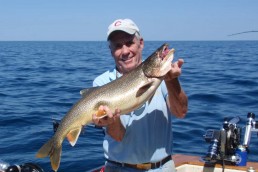Lake Michigan, What Can We Expect?
SHARE THIS POST
First of all, as you read this please bear in mind that it is a forecast, which is based on available facts and an educated guess, not much more. In some cases, when all the facts pertaining to a subject can be collected, analyzed and summarized, a reasonably accurate forecast is possible. In other situations, not all of the facts are known, and many variables exist that may alter those we do know and recognize.
A good example of “known facts” being altered by unrecognizable events was the Chicago Bears’ passing attack, which was forecasted (predicted) prior to the 2015 season to be one of the better in the league—a strong-armed quarterback, a healthier line and weapons to throw to were all facts. But then the leg injury of their number one draft pick and wide receiver, which was worse than first thought, lingered. Also, their usually dependable All-Pro tight end went into a season-long pout while nursing an injury, including staying at home while the team was playing and winning a game up in Green Bay.
But at least when trying to “forecast” the future offensive abilities of a football team, the certainty of the original offseason roster provides a good starting point. When attempting to forecast the state of the Lake Michigan fishery for this spring, we don’t even know who the “players” are going to be. And even if we did, the variables clouding the future are seemingly endless.
With this disclaimer in mind, here is my educated guess:
The effect of the introduction of exotic species—especially the zebra and quagga mussels—has been profound and harmful on the big lake. Virtually carpeting the lake’s bottom, the insidious little critters are filtering out the nutrients that constitute the base of the food chain at an alarming rate.
Simply put, it works like this: Big fish eat little fish, and the little fish eat the microorganisms the mussels are relentlessly devouring. When the little fish can’t find enough microorganisms to eat they begin to die off, which pushes the big fish toward starvation. The effect of this imbalance is becoming more apparent each year. Where it will lead, nobody knows.
On one hand, if the mussels continue to multiply and further deplete the base of the food chain, the entire fishery could collapse. On the other hand, the newly introduced exotics could reach a population high and then crash to a more sustainable level, and things could return to at least near normal.
As we head into the 2016 open-water Lake Michigan fishing season, here is where we are to the best of our knowledge:
Are you enjoying this post?
You can be among the first to get the latest info on where to go, what to use and how to use it!
Biological surveys have shown that the 2015 year-class of yellow perch was tremendous. Large schools of baby peach have been found lake-wide. The question is, with the shortage of food will they survive the winter? We won’t know until the result of the spring netting surveys are in. It would be great if the perch population received a much-needed boost, but it will take three years for the young perch to reach 8 inches in length.
Alewives also pulled off a highly successful spawning effort last spring, but as with the perch, their future depends on their finding sufficient food to survive the winter. Only time will tell.
Chinook salmon stubbornly will only eat alewives. As a result, their future is tied inextricably to the little baitfish’s abundance. If there are plenty of alewives we will have healthy chinooks, both in size and numbers. If alewives are scarce, there will not be many chinooks, and if so they will be small. If the alewives “crash,” you can say bye-bye to the chinooks.
Coho salmon are much more eclectic in their food choices, and will eat almost anything that gets in their way. Last summer they were discovered to be gorging on the baby perch that were seemingly everywhere. This spring we should have normal coho fishing as the salmon follow the spawning alewives inshore. Once the alewives move back out into the lake things will get tough, since the cohos will be forced to forage widely to find food and won’t be found in dense concentrations.
Lake trout, rainbow trout and brown trout are on a perpetual “see-food” diet; when they see food, they eat it. So far, these species have adapted to the lake’s changing conditions better than most, and they may well replace the salmon as the top predators. Without a doubt, record-size lake and brown trout are swimming around out there right now, along with plenty of trophy rainbow trout.
My only concern is for the lake trout, of which, there are a lot right now. And when they are biting they are very easy to catch. With the daily limit of these big fish being only two, the temptation is strong to box the limit, and then practice catch-and-release on many more. While this is surely fun, it does present a problem in that a good number of the released fish may not survive the stress of the encounter. We have to be careful not to overdo a good thing—there used to be a lot of buffalo once, too. Their numbers decreased significantly, and, finally now are back to higher levels.
So, that is my take on the upcoming Lake Michigan fishing season. As I pointed out, it is an educated guess, and nothing more.
MWO
SHARE THIS POST
Did you enjoy this post?
You can be among the first to get the latest info on where to go, what to use and how to use it!
Jerry Pabst
Jerry Pabst has been writing about the outdoors for over 40 years. He captained a Lake Michigan charter boat for 25 years and was inducted into the Fresh Water Fishing Hall of Fame. He has hunted waterfowl in all North American flyways, pursued upland game extensively, and trains his own dogs.



